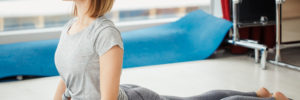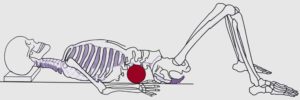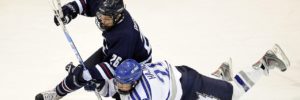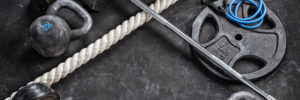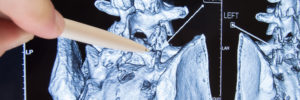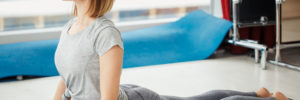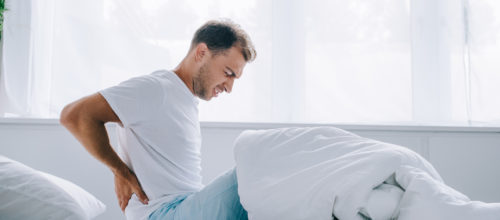
5 Back Pain Myths You Probably Don’t Know
Today I’m going to outline five back pain myths I learned during my journey of overcoming low back pain.
Back pain myths run rampant, and, unfortunately, steer people in the wrong direction. If overcoming low back pain is your goal then follow along as I discuss five common back pain myths destroying your progress.
Myth 1 – Bed Rest Is Helpful for Low Back Pain
People with low back pain are often put on bed rest; however, thanks to researchers, we know that prolonged bed rest can make back pain worse (7,8). While in bed, the spine is elongated, hindering the regular transport of nutrients into the disc, which may impede recovery of an injured disc (5,9). The spine is meant to move and absorb load, not wither away in a static position for days or weeks.
Also, researchers have shown that fully hydrated discs from a night of bedrest tend to show a 3x increase in annulus stresses during morning bending activities (1).
Simply put.
If one is put on prolonged bed rest (multiple days), they may only make their back pain worse.
Rather.
Learning to move correctly and understanding what triggers back pain is where people should focus their efforts.
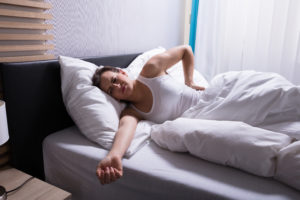
Prolonged bed rest may aggravate back pain due to abnormal expulsion of fluid from the disc that leads to higher stress with hyperhydrated discs (1,5,6,8,9). Image Licensed from “AndreyPopov/depositphotos.com”
Myth 2 – Sitting on a Stability Ball Helps Spare the Low Back
Once in a while, you’ll see an office worker sitting on a stability ball at their work station with the belief that it’s beneficial to their back.
Well.
Not so fast.
Gregory, Dunk & Callaghan (2006) found that sitting on a stability ball compared to a standard office chair has no added benefit and that people tend to perceive sitting on a stability ball as uncomfortable (3)! Similar results were found in another study by McGill, Kavcic & Harvey (2006) which compared sitting on a wooden chair to a stability ball and found no benefit from sitting on the stability ball (6).
So.
Next time you’re at work, and you’ve got the option of using a stability ball or office chair, I’d suggest you opt for the chair.
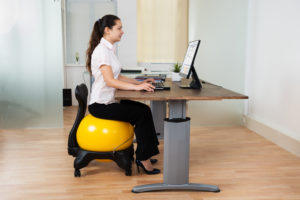
Sitting on a stability ball offers little to no back support and has no added benefit than a traditional chair. Image Licensed from “AndreyPopov/depositphotos.com”
Myth 3 – Sit-ups Are Better Than Planks for Building a Six-Pack
The sit-up places a large amount of compression on a flexed lumbar spine, and if repeated enough, this could create a disc herniation (2) or aggravate symptoms in a flexion intolerant person. I wouldn’t say this is the safest exercise for people looking to spare their low back.
Also, the sit-up relies heavily on the anterior hip to move the spine towards the thighs (4). While you think you may be doing a good job isolating the rectus abdominis (six pack muscles), you’re performing an exercise that does a great job of strengthening the hip flexors.
Unless you’re targeting the hip flexors or need to perform sit-ups as part of a competition assessment, I’d suggest avoiding sit-ups and sticking with planking variations. Planks spare the spine and work the abdominal musculature similar to a sit-up, but without the same compressive and flexion component.
Myth 4 – Non-Specific Low Back Pain
As Dr. Stuart McGill would say, there is no such thing as non-specific low back pain. Everyone’s low back pain has a specific cause and trigger. Grouping a symptom (low back pain) and placing them on the same program is a recipe for failure. Back pain could be a result of anything that may range from a herniated disc to a stress fracture or in an extreme case a tumour or cyst.
Myth 5 – Swimming and Yoga Are Helpful for Low Back Pain
In some cases, yes swimming and yoga can be beneficial. But if the swimming or yoga program is not individualized to the person’s back pain, or they don’t know how to perform various swimming strokes or yoga poses, then they could make things worse. For example, a person with extension-based back pain is not going to respond well to a breaststroke swimming style or Cobra pose.
If you have back pain, don’t just follow blatant recommendations about swimming and yoga.
Be smart.
And find a qualified trainer/coach if you’re unsure about how to swim, perform yoga, or aren’t sure about how your back pain may relate to swimming or yoga.
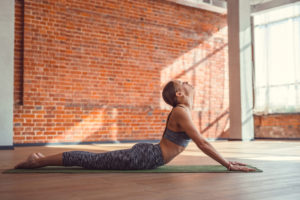
The cobra pose may feel suitable for some but could trigger symptoms in people with extension-based back pain. Image Licensed from “Deklofenaki/depositphotos.com”
In Summary
If you can avoid these five back pain myths, you’ll be off to a good start. To help guide you through your back pain journey, you can apply to my back pain coaching service for a free inquiry call.
Remember that progress, especially managing low back pain, takes education, time and lots of hard work. It doesn’t happen overnight, but with the right knowledge, and commitment, you can make progress.
Cheers,
Remi
References
1. Adams, M.A, Dolan, P., Hutton, W.C. (1987) Diurnal variations in the stresses on the lumbar spine. Spine. 12(2), 130-137.
2. Callaghan, J. P., & McGill, S. M. (2001). Intervertebral disc herniation: Studies on a porcine model exposed to highly repetitive flexion/extension motion with compressive force. Clinical Biomechanics (Bristol, Avon), 16(1), 28-37.
3. Gregory, D.E., Dunk, N.M., Callaghan, J.P. (2006) Stability ball versus office chair: comparison of muscle activation and lumbar spine posture during prolonged sitting. Human Factors. 48(1), 142-153.
4. Juker, D., McGill, S.M., Kropf, P., Steffen, T. (1998) Quantitative intramuscular myoelectric activity of lumbar portions of psoas and the abdominal wall during a wide variety of tasks. Medicine Science Sports & Exercise. 30(2), 301-310.
5. McGill, S.M., Axler, C.T. (1996) Changes in spine height throughout 32 hours of bedrest. Archives of Physical Medicine and Rehabilitation. 77(10), 1071-1073.
6. McGill, S.M., Kavcic, N.S., Harvey, E. (2006) Sitting on a chair or an exercise ball: various perspectives to guide decision making. Clinical Biomechanics. 21(4), 353-360.
7. Nachemson, A. (1992) Newest knowledge of low back pain: A critical look. Clinical Orthopaedics Related Research. 279, 8-20.
8. Malmivarra, A., Hakkinen, U., Aro, T., Heinrichs, M., Koskenniemi, L., Kuosma, E., Lappi S., Paloheimo, R., Servo., Vaaranen, V., Hernberg, Sven. (1995) The treatment of acute low back pain-bedrest, exercises, or ordinary activity? New England Journal of Medicine. 332(6), 351-355.
9. Urban, J.P.G., Holm, S., Maroddas, A., Nachemson, A. (1982) Nutrition of the intervertebral disc: Effect of fluid flow on solute transport. Clinical Orthopaedics.170, 296-302.

